
Cashew Cultivation
Cashew (Anacardium Occidentale) is a commercial crop that is important to the Indian economy and is primarily exported. There is huge potential for the crop in India due to the demand in domestic and world market. Currently, the raw cashewnuts produced in India are not sufficient for the processing industries and there is heavy dependence on African nuts for processing. There is a need to boost the raw cashewnut production and productivity through the adoption of Good Agricultural Practices (GAP) in cashew. The ICAR-Directorate of Cashew Research, Puttur in collaboration with the 14 AICRP centres have developed region specific 66 different cashew cultivars and hybrids and various other cashew production technologies for improving the yield of cashew. Some of the very important Good Agricultural Practices (GAP) have been discussed in this folder.
- Cashew requires a moderate climate; it will not tolerate prolonged periods of extreme cold and frost.
- The tree is very sensitive to cold when young, but becomes hardy with age and can withstand light frost for short periods.
- Cashew is grown in areas with rainfall ranging from 600-4500 mm per annum.
- Fruit set in cashew will be good if rains are not abundant during flowering and nut maturation stages.
- The land selected for the establishment of a cashew orchard should be cleared of trees and other weeds to avoid competition and ensure freshly planted grafts receive adequate sunlight for growth.
- Cashew can grow on a variety of soils except black soil, waterlogged, or saline soils. Free drainage must be ensured.
- Pits of 1 m x 1 m x 1 m dimensions should be dug at a recommended spacing across the slope. If there is a hardpan in the sub-surface of the soil, the dimensions of the pits should be enlarged to 1.2 m x 1.2 m x 1.2 m.
- Pits should be dug 15-20 days before planting and exposed to the sun to eliminate soil-borne pests, especially termites. Later, pits should be filled to a three-fourths level with a mixture of topsoil, 10 kg of compost, and 200 g of rock phosphate or single superphosphate.
| Planting Density | Spacing | No. of plants/acre | No. of plants/ha | Yield* (kg/ha) | Varieties recommended |
|---|---|---|---|---|---|
| Normal Density | 7 m × 7 m | 80 | 200 | 5000 | All varieties are suitable |
| 8 m × 8 m | 62 | 156 | 4400 | ||
| High Density* | 4 m × 4 m | 250 | 625 | 10950 | Pruning responsive varieties such as VRI-3, Nethra Ganga, NRCC Sel-2 and Bidhan Bonsai Kaju |
| 5 m × 5m | 160 | 400 | 9000 | ||
| Ultra-high density* | 3 m × 3 m | 444 | 1111 | 21000 |
* Cumulative yield for first 10 years
- Removal of alternate trees is recommended in the 11th year after planting for High Density and Ultra High Density planting.
- Healthy cashew grafts (more than five months old) of high-yielding varieties should be selected for planting, and seedlings should be avoided (plants obtained from seed nuts).
- While planting, it should be ensured that the graft union is at least 5 cm above ground level.
- After planting, the grafts should be supported with a stake (approx. 1m height) and second- and third-year stake length should be 2-3 m. The graft should be tied by a loose knot to the stake to avoid damage by wind and chicken mesh should cover to avoid wild animal’s damage.
- Avoid planting cashew as an intercrop, as growth will be inhibited under shade.
Application of 10-15 kg Farmyard Manure or compost per plant is found beneficial. Fertilizer application should be done as per the recommended dosage.
| Year after planting | Urea (g/ plant) | Rock phosphate (g/ plant) | Muriate of Potash (g/ plant) |
|---|---|---|---|
| I | 330 | 125 | 40 |
| II | 660 | 250 | 80 |
| III | 990 | 375 | 120 |
| IV | 1320 | 500 | 160 |
| V and onward | 1650 | 625 | 200 |
East coast and interior region (soil is loamy and receives low rainfall)
- The fertilizer should be applied in 50 cm wide circular strips at a distance of 0.5 m, 0.7 m, 1.0 m and 1.5 m away from the trunk during 1 st , 2 nd , 3 rd and 4 th year of planting.
West coast (Laterite soil and soils of slopy lands, receiving heavy rainfall)
- The fertilizer should be applied in circular trenches of 25 cm width, 15 cm depth at a distance of 0.5 m, 0.7 m, 1.0 m and 1.5 m away from the trunk during 1 st , 2 nd , 3 rd and 4 th year of planting.
- Immediately after application, fertilizer should be raked into the soil.
- Fertilizer application should be avoided during heavy monsoon and when the soil moisture status is poor.
- The pits should be provided with side drains to avoid water stagnation.
- Regularly remove the sprouts that appear on the root stock below the graft joint using secateurs.
- Deblossoming should be carried out during the first two years after planting under normal density planting and for high density & ultra-high density, deblossoming can be done in the first year only.
- Pruning and canopy management is important in cashew especially in high density planting system and pruning needs to be taken up every year after harvest of the crop (usually during May-June).
- Light pruning should be done in normal density at 2-year interval to give umbrella shape & removal of dead, discard & intermingled branches.
- After pruning 10 % Bordeaux paste must be swabbed on the large cuts or 1% Bordeaux mixture spray is recommended for pruned shoots.
- No branches should be allowed upto 3 feet height from base for normal density and 2 feet from the base for high density and ultra high density for proper canopy development.
- After 4-5 years the main branch growing vertically should be cut at a height of 3.5 m to 4.0 m in Normal density planting & 1.5 to 2.5 m in Ultra high-density planting and High density planting respectively in order to promote lateral shoot for better fruiting.
- Weeding should be done twice a year depending on intensity by manually or mechanically and after basin weeding, soil should be mounded near trunk up to 1-1.5 feet for proper anchorage.
- Application of fertilizers, however, can be taken up during the second week of August during the break in monsoon.
- Plant protection spray should be taken for Tea Mosquito Bug if incidence noticed. The spray should be done at regular intervals. (Flushing, Flowering and Fruit set stage).
- In the case of slope lands, terracing should be taken up around each plant within the third year. Terraces should be of a 1.8 m to 2.0 m radius with a catch pit [2 m (L) × 0.3 m (w) × 0.45 m (D)] on the upper side of a slope.
- The soil around the plant should be mulched with organic matter during the rainy season to prevent soil erosion and direct exposure to sunlight there by conserving soil moisture.
- Supplementary irrigation during January to March at fortnightly intervals @ 200 liters per plant has proved to increase nut yield and Drip irrigation to the crop @ 60-80 liters of water per tree once in four days from flower initiation till fruit set and development also increases yields significantly.
- Intercropping cashew with annual crops in the first few years is highly recommended in order to cover the operational costs associated with managing the farm.
-
The distance from the main stem of the cashew tree to the intercrops should be:
- 50 cm in the first year,
- 1 meter in the second year,
- and one additional meter for each consecutive year until there is no more space.
- Intercrops should not be planted close to the tree stem as they will physically obstruct the control of diseases and insect-pests.
- The annual vegetables, flowers, medicinal plants, aromatic plants, and millets of the particular location can be cultivated.
-
Some of the intercrops grown successfully under cashew cultivation include:
- Okra
- Cowpea
- Dolichos bean
- Cluster bean
- Green gram
- East Indian arrowroot
- Yard long bean
- Chilli
- Brinjal
- Cabbage
- Cauliflower
- Knol khol
- Elephant foot yam
- Colocasia
- Marigold
- Chrysanthemum
- Crossandra
- Aster gaillardia
- Ginger
- Turmeric
- White turmeric
- Black turmeric
- Aromatic turmeric
- Mango ginger
- Sweet potato
- Keukand
- Tapioca
- Groundnut
- Kodo millet
Though the cashew is infested with many pests, the Tea Mosquito Bug (TMB) and Cashew Stem and Root Borer (CSRB) are most damage causing pests.
Tea Mosquito Bug (TMB)
In general, TMB incidence commences during October to November coinciding with the emergence of new flushes after the monsoon. The population reaches a maximum during December to January when the plants are in full bloom and its activity is seen until harvest. The pest infests tender leaves, shoots, panicles, immature nuts as well as immature apples.
Symptoms
Initially water-soaked lesions appear at the feeding sites which turn scabby black in 2-3 days. Later, the lesions coalesce and ultimately results in drying of shoots and leaves. In the panicle it results in blossom blight where the flowers and stalks completely dried up. Upon severe damage most of the flushes and panicles dry up and panicles dry up and the tree develops a scorched appearance.
Control measure: Lambda cyhalothrin (0.6 ml/lit), thiamethoxam (0.2 g/lit) and acetamiprid (0.5 g/lit) spray whenever the incidence occurs at 5-10% damage.
Cashew Stem and Root Borer (CSRB)
In general, the pest incidence observed from December to May month.
Symptoms
At the base of the CSRB infested tree, gum and fibrous material are exuded in small quantities in the initial stage of attack. During later stages of attack, the infested tree canopies show a sickly appearance and the green leaves turn yellowish and start dropping prematurely. In the severe stages of attack, the twigs dry off and the bark on the trunk starts splitting. At this stage, large quantity of chewed fibers and gum (commonly known as frass) are seen as big lumps at the base of the CSRB infested tree.
Control measure:
Cultural method:
- Phyto-sanitation of the cashew plantations help to reduce the pest population
- The young plants should be trained to have branching at height of 0.75 – 1.0 m from ground
- Once the larvae enters into the wood for pupation, it is difficult to locate. Hence, it has to be killed by inserting a gear wire/any bending metal wire.
Chemical method:
- The pest stages have to be carefully removed by careful chiselling of the tunnels in the infested portions.
- The chiselled portion should be swabbed thoroughly with chlorpyriphos 10 ml/lit or Fipronil 2 ml/lit and subsequently the tree base should also be drenched.
The economical yield commences from 3rd year and the tree will be in full production after 4-5 years depending on spacing and they continue bearing for several years. In India, the main harvesting season is February-May. Though cashew plants come to flower in the first year after planting, only from third year onwards plant should be allowed to set fruits. Average yield per tree increases from 2 kg at ages 3-5 years to 4 kg at ages 6-10 years to 5-10 kg at ages 11- 15 years and to more than 10 kg at ages 16- 20 years depending upon variety and management.
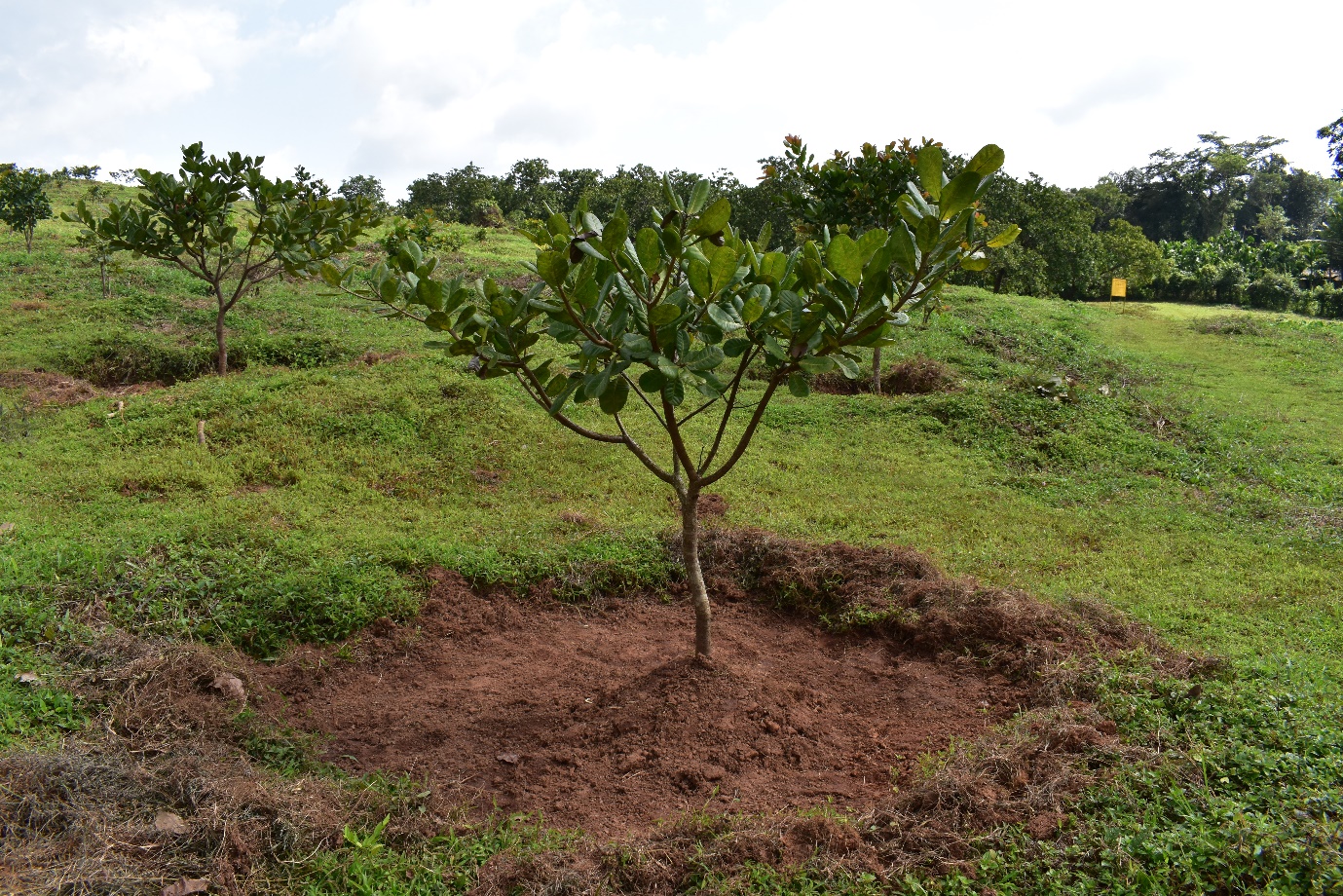
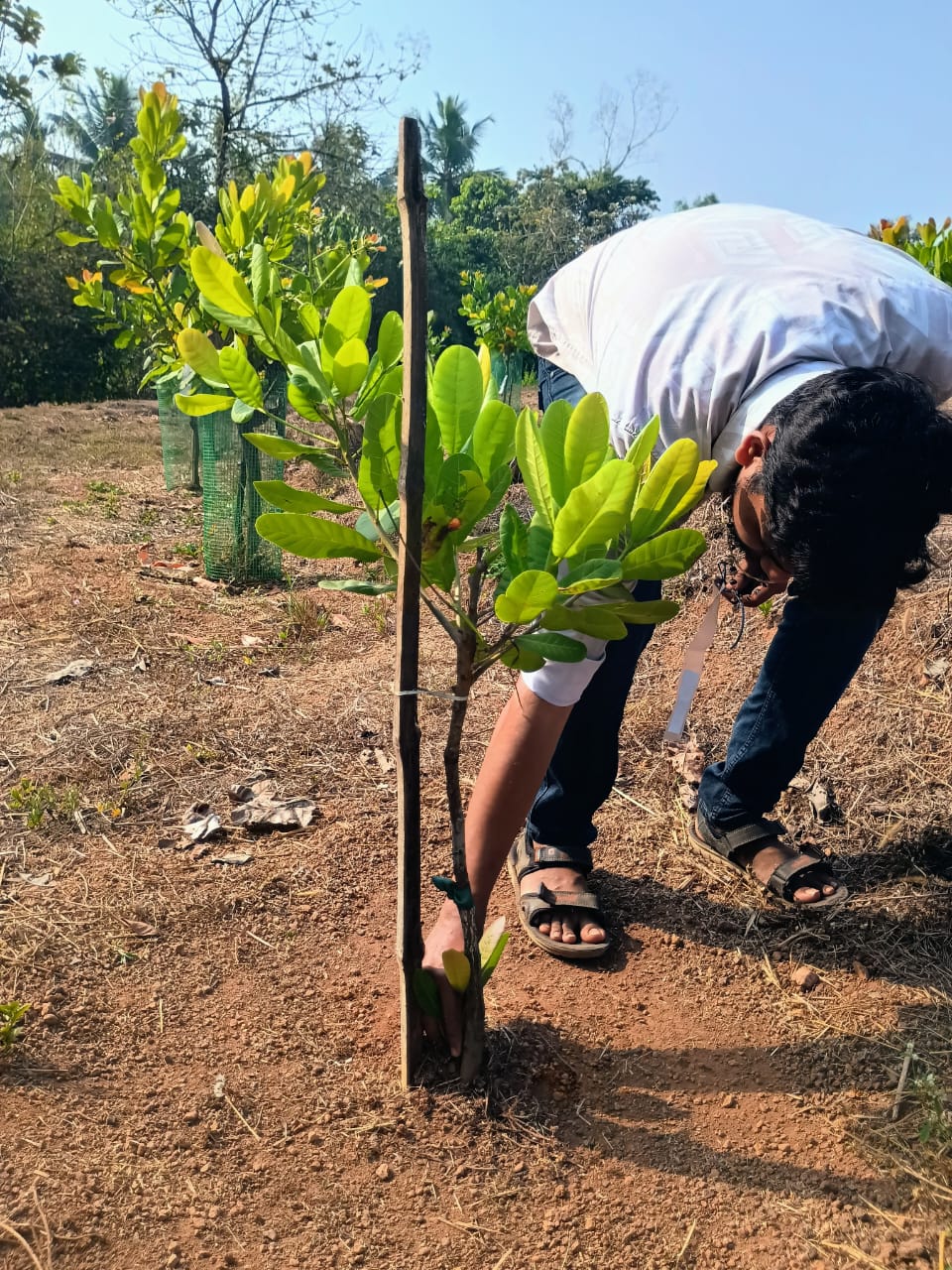

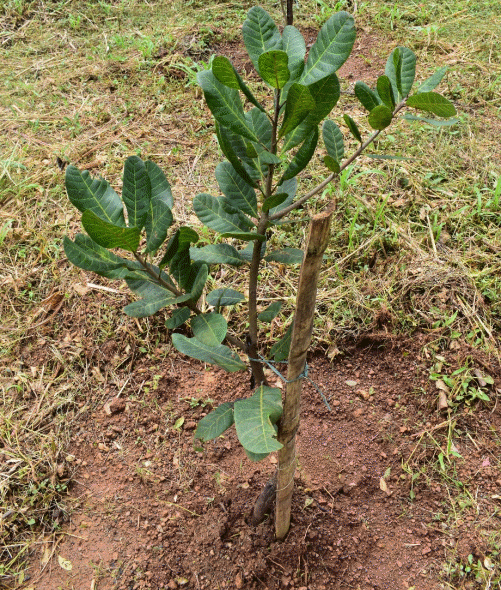
Two fungal diseases, anthracnose and gummosis diseases are considered to be important in different cashew growing regions of India.
Anthracnose disease
Symptoms
Initially elongated dark brown to black water-soaked lesions on shoots later it will dry up and leaves which become crinkled, dry up and fall off. Small dark spots are formed on main stalk and lateral branches of the panicle, the flowers eventually wither and drop down and floral branches show drying symptom. Immature fruits turn black and fall prematurely. On mature fruits black irregular or roundish spots develop those are often sunken and gradually start rotting. The disease is more severe when rainfall coincides with flowering season. Small black spots appear on nuts and apples and it becomes mummified.
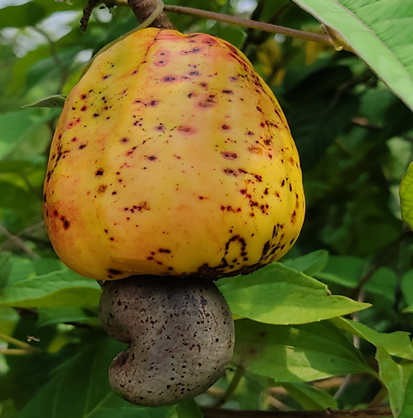
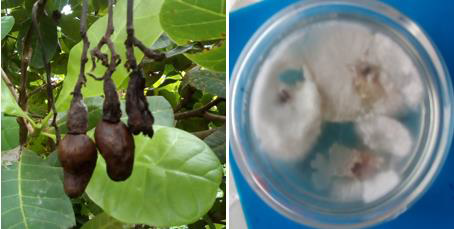
Management
The anthracnose disease can be effectively managed by spraying plants and seedlings with the help of protective and curative fungicides.
The affected plant parts should be pruned and burnt to prevent the spread of the disease. Spraying with 1 % Bordeaux mixture or Mancozeb 0.25% or copper oxychloride 0.3%.
As Infection of the fungus is usually preceded by infestation of mosquito bug, combined application of insecticide and fungicide is effective and more economical.
Gummosis disease
Symptoms
Initially the symptom will exhibit as gum oozing from small cracks of the infected parts and reddish-brown liquid from the main stem and branches which later turn black in colour giving tree bleeding appearance. The most diagnostic symptom is gum exudation followed by leaf yellowing and leaf drop. Longitudinal cracks also appear on the affected region from which gum exudes. The inner tissues of the affected portions turn reddish brown having small cavities filled with reddish fluid and the affected branches dry gradually.
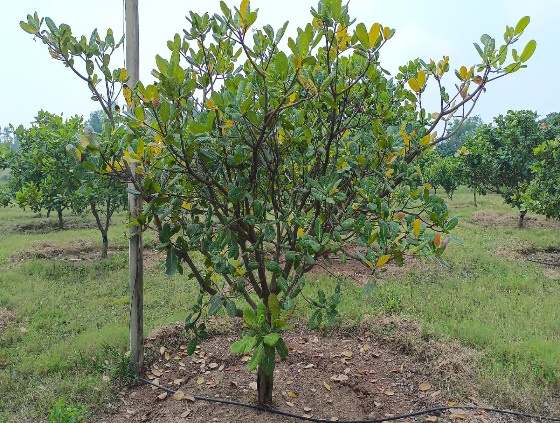
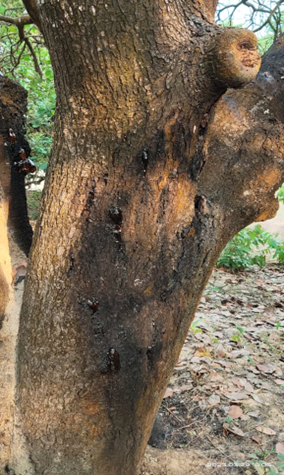
Management
Monitor the cashew plantations regularly and keep clean, prune the unproductive, dry and disease/ insect infected branches.
Chiseling out the affected plant portions and applying Bordeaux paste (10 %) or swabbing the cut portion with suspension of copper oxychloride (0.3 %). Spraying of mancozeb (0.2 %) or Bordeaux mixture (1 %) is found effective.
Spray Bordeaux mixture 1% thoroughly on the whole plant after harvest and repeat again at fruit setting. If the bark is cracking or has mechanical injury, use Bordeaux paste 10% immediately.

